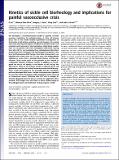| dc.contributor.author | Du, E | |
| dc.contributor.author | Diez-Silva, Monica | |
| dc.contributor.author | Kato, Gregory J. | |
| dc.contributor.author | Dao, Ming | |
| dc.contributor.author | Suresh, Subra | |
| dc.date.accessioned | 2015-09-08T15:27:51Z | |
| dc.date.available | 2015-09-08T15:27:51Z | |
| dc.date.issued | 2015-02 | |
| dc.date.submitted | 2014-10 | |
| dc.identifier.issn | 0027-8424 | |
| dc.identifier.issn | 1091-6490 | |
| dc.identifier.uri | http://hdl.handle.net/1721.1/98387 | |
| dc.description.abstract | We developed a microfluidics-based model to quantify cell-level processes modulating the pathophysiology of sickle cell disease (SCD). This in vitro model enabled quantitative investigations of the kinetics of cell sickling, unsickling, and cell rheology. We created short-term and long-term hypoxic conditions to simulate normal and retarded transit scenarios in microvasculature. Using blood samples from 25 SCD patients with sickle hemoglobin (HbS) levels varying from 64 to 90.1%, we investigated how cell biophysical alterations during blood flow correlated with hematological parameters, HbS level, and hydroxyurea (HU) therapy. From these measurements, we identified two severe cases of SCD that were also independently validated as severe from a genotype-based disease severity classification. These results point to the potential of this method as a diagnostic indicator of disease severity. In addition, we investigated the role of cell density in the kinetics of cell sickling. We observed an effect of HU therapy mainly in relatively dense cell populations, and that the sickled fraction increased with cell density. These results lend support to the possibility that the microfluidic platform developed here offers a unique and quantitative approach to assess the kinetic, rheological, and hematological factors involved in vasoocclusive events associated with SCD and to develop alternative diagnostic tools for disease severity to supplement other methods. Such insights may also lead to a better understanding of the pathogenic basis and mechanism of drug response in SCD. | en_US |
| dc.description.sponsorship | National Institutes of Health (U.S.) (R01HL094270) | en_US |
| dc.description.sponsorship | National Institutes of Health (U.S.) (U01HL114476) | en_US |
| dc.language.iso | en_US | |
| dc.publisher | National Academy of Sciences (U.S.) | en_US |
| dc.relation.isversionof | http://dx.doi.org/10.1073/pnas.1424111112 | en_US |
| dc.rights | Article is made available in accordance with the publisher's policy and may be subject to US copyright law. Please refer to the publisher's site for terms of use. | en_US |
| dc.source | National Academy of Sciences (U.S.) | en_US |
| dc.title | Kinetics of sickle cell biorheology and implications for painful vasoocclusive crisis | en_US |
| dc.type | Article | en_US |
| dc.identifier.citation | Du, E, Monica Diez-Silva, Gregory J. Kato, Ming Dao, and Subra Suresh. “Kinetics of Sickle Cell Biorheology and Implications for Painful Vasoocclusive Crisis.” Proceedings of the National Academy of Sciences 112, no. 5 (February 3, 2015): 1422–27. | en_US |
| dc.contributor.department | Massachusetts Institute of Technology. Department of Materials Science and Engineering | en_US |
| dc.contributor.mitauthor | Du, E | en_US |
| dc.contributor.mitauthor | Diez-Silva, Monica | en_US |
| dc.contributor.mitauthor | Dao, Ming | en_US |
| dc.relation.journal | Proceedings of the National Academy of Sciences | en_US |
| dc.eprint.version | Final published version | en_US |
| dc.type.uri | http://purl.org/eprint/type/JournalArticle | en_US |
| eprint.status | http://purl.org/eprint/status/PeerReviewed | en_US |
| dspace.orderedauthors | Du, E; Diez-Silva, Monica; Kato, Gregory J.; Dao, Ming; Suresh, Subra | en_US |
| dc.identifier.orcid | https://orcid.org/0000-0002-0301-0891 | |
| mit.license | PUBLISHER_POLICY | en_US |
| mit.metadata.status | Complete | |
